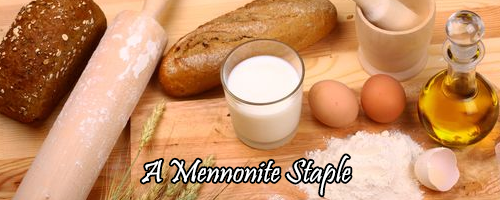Mennonite Morsels: A Mennonite Staple
Author: Adanys Wynterwulf, April 2018
- A Mennonite Staple
Hello! Before getting on with my first article in the series I am calling Mennonite Morsels, I thought I’d go ahead and introduce it, and myself a little bit too. I am a former Mennonite who still lives among the people. It is very much at the core of who I am today in spite of me not adhering to the faith anymore. The culture remains a part of me though I am no longer a part of it. Growing up, I always knew we lived differently than others did, I could see I wasn't the same as other kids. I dressed differently, spoke a different language, and lived by different rules. I also ate different food. We didn't go out to eat much, and family dinners were, and are, a huge part of my family's life. And it was good food, let me tell you. So good, in fact, that I want to share it with you.
Now, I can't give you the entire background and origins of each recipe, the changes it went through, and its place in our culture today. I didn't study Mennonites, I just lived the life. The recipes aren't always going to be traditional, but rather one that is popular in my family, with modifications my mom has made to them over the years to make them unique to us.
So the first recipe I will be sharing with you is one that is a staple in nearly every Mennonite home; at least, in all the ones I’ve known. It’s often served on Sunday for faspa. Faspa is simple meal served in the late afternoon but often takes the place of supper. The items on the menu most often are kringel, tweebak, jam, cheese, cookies, coffee, and sugar cubes. Sugar cubes?! Yes. Let me elaborate. Often they’ll take a kringel, cover it in some butter and munch on that, then dip a sugar cube in their coffee and eat it alongside. It’s strange, and so totally Mennonite. This staple is often served for faspa, but that’s not all. You can have it for breakfast, alongside meals, or on its own. So what is It?
Tweebak! Or bread rolls. Wikipedia defines it as “a yeast bread roll formed from two pieces of dough that are pulled apart when eaten.” I don’t know about the two pieces of dough, ours were always just one golf ball sized piece of dough and “rolled” on the table and left to rise. I’ll explain the procedure more in depth when I get to the instructions. It’s a learned skill, so don’t be surprised if yours aren’t smooth and round on your first try.
So, on to the recipe. I’m going to be sharing a modified version my mom always makes.
- Ingredients
¾ cup corn oil (lard works too, and is more traditional)
2 ½ cups water
¾ Tbsp yeast
¾ Tbsp salt
¾ Tbsp sugar
⅓ cup wheat bran
¼ cup fine whole wheat flour
- Directions
Preheat oven to 400 F. Warm water to about 100 F, and mix oil/lard, - if using lard, make sure to liquefy it first - yeast, sugar, and salt until the yeast has dissolved. Then slowly add the flour and bran, mixing it in thoroughly, kneading when the dough becomes too thick to stir.
After kneading the dough, place it in a bowl, cover it, and allow to rise for half an hour, then knead one more time and set to rise again, this time for 1 hour.
After the dough has risen, cut or pinch off golf ball sized or slightly larger pieces. Then, on a well oiled surface - to prevent the dough from sticking - take one piece of dough, place it on the table, place your hand on top, and loosely curl your fingers, making a sort of C shape; your pinky should be on the table. Keep your pinky and ring finger firm, while your other fingers are loose and relaxed, then begin gently but firmly moving your hand in a circular motion, rolling the dough. The goal is to get a firm, smooth ball, and if it’s done right, there should be a small hole on the bottom. If there isn’t, don’t despair, it comes with practice.
Place the rolls on a cookie sheet and leave room between them as they will expand to more than twice their size in rising and baking. After they’re all rolled out, cover the sheets to prevent the dough from drying out, and allow them to rise until they double in size. If your cookie sheets come with a lid, that will work. Or you can do as the Mennonites do: first cover them with a towel, and then lay a sheet of plastic on top to make it more airtight. Obviously, I’m not recommending using bath towels, but these towels were always thin and used specifically for this purpose.
Place the rolls in the oven - be gentle with them, as they can fall and you’ll end up with misshapen lumps- and bake until they are golden brown.
Allow them to cool, then serve with butter or jam, or butter and jam! They’re at their most delicious fresh out of the oven. After they have cooled, keep them stored in the freezer to maintain their freshness. They dry out quickly if stored at room temperature, and even more quickly if refrigerated.
Feel free to reach out to me if you want me to explain any of this further. So, thank you for reading, and be sure to let me know if you decide to try this and what you think.
